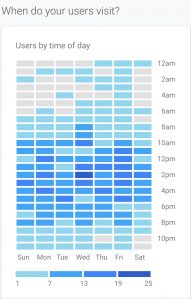Digital Marketing Strategy.

A Simple Science
Cast your memory back to year 10 science class. Do you remember the simple formula for testing a hypothesis?
Digital marketing campaigns resemble a similar basic formula.
In order to achieve desired results (generally increased sales conversions), campaigns must be monitored, scrutinised and tweaked constantly.
These marketing strategies continuously grow and ‘learn’ to become more efficient, each and every cycle.
What Do We Learn?
Hyper-targeting:
You may have also heard of the term ‘Hyper-targeting’.
Hyper-targeting is the ability to target very specific audience-segments with relevant advertising content.
Examples of some Hyper-targeting Segments:
-
Location
-
Demographic
-
Interests
-
Situation
-
New Vs Returning Customers
-
Household income
-
Martial Status
The real key to Hyper-targeting lies in the ability to deliver highly specified, niche content that is relevant to an individual segment, and to also monitor the performance of the different segments.
Analysing the results allows us to quickly and effectively narrow down the advertising reach, to ensure we are only targeting the segments that will actually convert to sales.
Basically, the tools we have to run digital marketing campaigns are extremely powerful, precise and very effective.
However! Before we can start hypothesising about how to segment customer base. There should be one single burning question…

Who is your customer?
When we start the digital marketing conversation with business owners and business managers, one of the first questions we like to ask is: Who is your customer?
Generally speaking, the answers vary quite significantly.
What we find is:
-
Around 25% of the time, directors really don’t have a solid answer for us.
-
Another 25% that we ask, provide us with a simple breakdown of either a rough age (usually in 20 year gaps i.e. 25 – 45), other basic demographics or location.
-
In larger businesses, managers tend not to agree with each other on a definitive answer.
These answers are all OK!
We have powerful marketing tools that provide metrics to remove the question.
What does your customer REALLY want? Equally important, REALLY don’t want?
Data from our digital campaigns help answer some other significant questions:
-
What excites your customers?
-
Where your customers are located?
-
What attracts your customers to your business?
-
Which marketing efforts are repelling your customers?
-
What could your customers care less about?
-
When are your customers likely to buy?

Think Point:
Metrics also provide valuable insight into what your customers don’t want. Eliminating the chance of your precious marketing dollars driving away your regular customers.
The POWER of analytics beyond Marketing & Advertising.
The powerful metrics that we gain for your business through this digital marketing process are incredibly valuable for the everyday running of your business.
This number crunching process is able to provide a full picture of your customer’s spending habits and general behaviour.
Above and beyond!!! Marketing Analytics provide your business with:
-
Up-to-date industry trends
-
Concentrated locations of your key customers
-
Your key customer demographics
-
Your future inventory needs
-
Mapping out key times and periods for staffing
Example: A chart for your website’s busiest times of day.
The below heat map (source: Google Analytics) above gives a breakdown of which hours of the week customers are visiting the website of one of our clients.

How could this heat map provide a benefit to your business beyond marketing?
A business might find this data useful when structuring the lunch breaks of their customer service/ receptionists for example. Some days it might be beneficial for staff to take their breaks later or earlier in the day.
Simple actions such as this will help to ensure your phones and support lines are manned when they are most likely to ring.
In this day and age, customers are likely to be shopping around from their computer or mobile device. Simply, a phone call diverted to message bank, or an email that is not responded to straight away, is quite likely going to result in a lost sale.
It’s the small things in the day-to-day operations, that add up to that help boost your revenue and keep your customers coming back.
Final Think Point:
It’s unlikely that customers of ANY business in the world, are purchasing consistently year round. Busy and quiet months are a normal part of any business cycle.
What is your busiest week or month or season?
